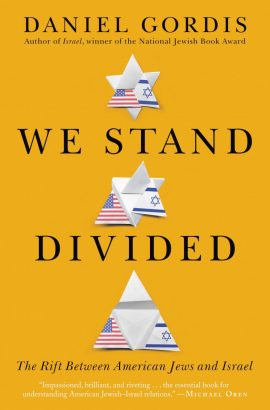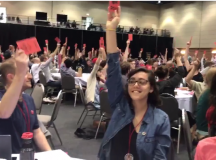Daniel Gordis’s We Stand Divided is the latest book on the growing rift between American Jews and Israelis. What distinguishes Gordis’s work is the way he locates the relationship, for him now at an ‘all-time nadir,’ in the histories of both countries. While Israelis have long been impatient with Americans who are seemingly unaware of the survivalist imperative for a small country in the Middle East, Americans have for generations believed that Israelis have abandoned the core values that should make Jewish democracy thrive.
Gordis traces a continuing history of mutual condescension and misunderstanding: David Ben-Gurion in 1960, for example, lamented an American Judaism ‘losing all meaning,’ in ‘slow and imperceptible decline’. Peter Beinart, a spokesman for a vibrant contemporary and left-leaning Judaism, expresses the resentment of a generation being asked to ‘check their liberalism at the door’ in all manners concerning Israel. What drives a misunderstanding that approaches outright antagonism, Gordis suggests, is that unlike in Europe, a reference point for many Israelis, there has been no ‘Jewish Question’ in America. Indeed, with Judaism defined as a religion and not as a people, American Jews have been able to claim that they are on the playing field with other minorities. To be a Jew in the US is to be no different from being Irish, Italian or Indian – part of the melting pot. From this universalistic point of view of many American Jews steeped in the traditions of liberalism, Israel’s nationalism and particularism not only erode, but are contrary to democratic values.
Gordis attempts to balance the legitimacy of the claims of American Jews and those of Israelis, warning in conclusion against non-pragmatic idealisms, indeed urging compromise, acknowledging that neither American nor Israeli ‘will be the perfect partner the other seeks’. In the end, however, the argument is tilted, subtly but strongly, towards Gordis’s conception of the Israeli point-of-view. Given the choice between a Judaism based on justice or survival, the choice (unless blinded by a particularly American naiveté) is clear. In this vein, Gordis lists various instances of 20th century American antisemitism – starting with Henry Ford and Charles Lindbergh, moving through Father Coughlin and McCarthy, and leading to Louis Farrakhan, and ending with the Tree of Life Synagogue killer screaming out, ‘All Jews must die.’ Gordis is no doubt genuine when saying that ‘Israelis take no satisfaction when such events are reported,’ though in the story he tells, the writing for Americans is clearly written on the wall, or at least should be.
We Stand Divided is most effective in providing the backdrop for contemporary American attitudes towards Israel. The Reform Jewish gathering in Pittsburgh in 1885 adopted a platform which rejected all expressions of Jewish particularism; later, the Reform-led protest against the Balfour Declaration for a ‘Jewish Homeland’ rejected the notion that Jews constitute a nation. After Israeli statehood, a Reform congregation in Houston, Gordis writes, did not allow declared Zionists to join their congregational ranks, and even Albert Einstein – later offered the Presidency of Israel – worried about the ‘inner damage’ that Judaism would sustain by the development of a ‘narrow nationalism’. For some in America, Gordis suggests, the horrors of the Nazi terrors might be erased, or at least repressed, through the continued embrace of an American myth of a universalist sphere of toleration and equality.
In the context of an ethos of American tolerations – without the history of European antisemitism – many Jews proclaimed an end to exile, not, however, in Jerusalem or Tel Aviv, but in Brooklyn and Boston where some even proclaimed: ‘America is our Zion’. That mythic perspective has had amazing resilience. But, as Gordis’ work so compelling describes, the American idealised conception of Zion was forced, eventually, to encounter the messiness of history. That is, idealisations about American toleration for Jews eventually gave way to an experience of the continued reality of anti-Semitism.
The dichotomy that informs We Stand Divided, however, is not only sustained by a certain myth about America – a myth which is anyway, as Gordis shows, now in decline – but also by a parallel idealisation of the State of Israel. This myth, though mostly obscured by the appearance of balance achieved in We Stand Divided, becomes explicit in the fantasy expressed in Gordis’s imagining the first responses of young visitors upon their arrival at Ben-Gurion Airport:
Part of what they fall in love with is that the society is so Jewish in so many ways. The young woman behind the plexiglass window at passport control is Jewish, and so is the man fixing the conveyor belt at baggage claim and the man or woman mopping the floor in the airport terminal.
New visitors, in Gordis’s representation, note with pride the Jewishness of the Jewish state, right down to the egalitarian underclass.
In another instance of waxing poetically about Israel, Gordis meditates on the sound of sirens announcing the beginning of the sabbath on Friday afternoons in Jerusalem:
Why sound the siren on Friday afternoons? At the time the Temple stood, the shofar was sounded from the Temple Mount’s southwestern corner rooftop as Shabbat began; today that ‘public announcement’ of Shabbat is replicated by the air-raid siren. There is no Temple in Jerusalem anymore, but for a few seconds each week Jerusalemites live as if there were.
This is a lovely idealisation, something perhaps to be shared at a shabbat table on a Friday night, but certainly not experienced by all Jerusalemites. Even for those from whom the siren does have religious significance (not all Jerusalem residents are religious, and 34 per cent of the population is Muslim), the meaning is almost always pragmatic – take the chicken out of the oven, mop the floors, get in line for the shower.
In a similar manner, Gordis attributes the success of the Birthright programmes (bringing young American to Jews to Israel for the first time) to the encounter with something beyond the ‘homogenised Judaism of their Hebrew schools’. For the first time, Gordis enthuses, they see landscapes that take on ‘an air of drama and poignancy when they learn that their Biblical forbears walked those same hills,’ when they see history becoming ‘real’ as they visit the Jewish people’s ‘places of triumph and tragedy’. To be sure, there is something to those ‘magic encounters’ with history however idealised they may be. But there is a different reality, and a different Israel that makes Gordis’s dichotomy between American Jews and Israelis not only difficult to maintain, but of limited value for discussions about the relationship and, more importantly, for Israel’s future.
Indeed, what many Americans may feel as they arrive to Israel’s Ben-Gurion is a different Jewish vibe – not Jewish uniformity, but rather the diversity of the people in the Arrival’s Hall – not only a variety of Jews, secular, religious, but also Arabs, Muslims and Christians. That is, arriving in Israel not only does away with the homogenised Judaism of Hebrew School, but the homogenised Israel of the Aliyah brochures, from decades past, for new immigrants. Gordis does point to the ways in which Americans have brought awareness of pluralism to Israel society, but the Israeli society about which he writes shows no signs of that pluralism.
When, for example, Gordis writes about the controversial Nation-State Law, passed in 2018 by the Knesset but stalled in the High Court of Justice, that Israelis were ‘befuddled by the brouhaha’ – ‘why all the commotion that over a law that seeks to affirm something most Jews firmly believe: that Israel is the nation-state of the Jewish people?’ – Gordis’s idealistic construction of his Israel obscures the diversity of perspectives among contemporary Israelis. None other than the President of Israel Reuven Rivlin, in a letter to the Knesset asked: ‘In the name of the Zionist vision, are we willing to lend a hand to the discrimination and exclusion of a man or a woman on the basis of his or her origin?’ The ‘brouhaha’ was not then only of American manufacture, but part of a real and still live dialogue about what constitutes Israeli national identity. Aside from the President, others still ask: Why should Jews, the demographic and political majority, living in a state that already prioritises and privileges their needs and their forms of religious and national expression, support such a law? True, as Gordis point out, Ben-Gurion talked about the importance of ending ‘mixed communities,’ and creating spaces in which ‘Jews could once again thrive as Jews without feeling constrained by others’. But that was in 1924. Gordis derides the idea of what he calls, following the Catholic theologian Richard John Neuhaus, the importation of the American ideal of the ‘naked public sphere,’ devoid of any values, but there may be different ways of maintaining a free public sphere (dropping Neuhaus’s loaded ‘naked’), while at the same time inflecting it with Jewish values.
Such values might emerge from a conception of Israel that considers a ‘messiness’ not accounted for in Gordis’s fantasy Israel. Anyone walking into a pharmacy, a health clinic, a hospital, or a university classroom will note the way in which Israel – over the past decade or so – has changed radically. The public sphere in Israel is indeed transforming, and for the better. In my English Literature classroom at Bar Ilan University, for example, ten years ago there would have been one or two Arab Students among 50, now there are at least 20 – both Muslims and Christians. Gordis shows a willed indifference to this reality in his discussion of the controversy over the Jewish National anthem, ‘HaTikva’ which explicitly celebrates the Jewish homeland and the Jewish soul. Gordis acknowledges that this is a song Arabs find impossible to sing, but then concludes that Israelis are cognisant of the problem, but ‘willing to live with that tension’. What gets lost here is that Arabs are also Israelis whose experience of tension in Gordis’s idealised representation is simply ignored.
Overlooking Gordis’s uniformly Jewish (and religious) Israel, there is a different Israel, not evident so much on the national stage, but quietly, on campuses, in hospitals, in a variety of places in the public sphere, where dialogue and coexistence between different kinds of Israelis is happening. In the classroom culture that my colleagues and I nurture, we find that young Israelis – of all nationalities and religions – want to share their voices, and to acknowledge the voices of others. This is not to say Israel will ever be a democracy in the American model, or even that it should be, but that there may be more in common between the ideals of Americans and Israelis than first appears.
Israel was founded through its realisation of its dreams of national statehood. But in the 21st century, it may be the universalist aspects of Judaism that shows Israel fulfilling its mission as an exemplary nation – a light to the nations through welcoming the stranger and tolerating diversity. While the generation after 1967 may have looked to the Book of Joshua for inspiration, we may need the very different inspiration of Isaiah as a way of realising Israel’s more universalist aspirations. Those, however, who maintain faith in fantasies – either that of a fantasy Israel built according to the utopian ideals of American democracy or that of Israel conceived as a uniform and homogenous Jewish state – will likely not help in leading the Jewish state into the future.




































